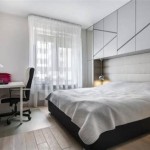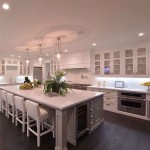How Much Are Interior Decorators? Understanding Interior Decorating Costs
Engaging an interior decorator can transform a living space, imbuing it with style, functionality, and a personalized aesthetic. However, one of the primary considerations for homeowners contemplating this service is the cost. The expense of hiring an interior decorator can vary considerably based on numerous factors, making it essential to understand the pricing structures and potential influencing elements to budget accordingly.
The cost of an interior decorator is not a fixed amount; it is a dynamic figure influenced by the scope of the project, the decorator's experience and expertise, the location of the project, and the chosen pricing model. Before hiring a decorator, potential clients should have a clear understanding of their budget and a well-defined scope for the project to facilitate effective communication and avoid unexpected expenses.
Factors Influencing Interior Decorator Costs
Several key factors contribute to the overall cost of engaging an interior decorator. These factors can be broadly categorized into project scope, decorator expertise, location, and pricing model. These elements interact to determine the final investment required for a successful interior decorating project.
The scope of the project is a significant determinant of cost. A simple room refresh involving paint selection, furniture rearrangement, and accessory placement will typically cost less than a complete home renovation requiring structural modifications, custom furniture design, and extensive material sourcing. The size of the space also plays a role; decorating a large house will naturally be more expensive than decorating a small apartment due to the increased material quantities and labor hours involved.
The decorator's experience and expertise also affect the price. Highly experienced decorators with a proven track record and specialized skills in certain design styles or project types often command higher fees. Their expertise can translate into more efficient project management, access to exclusive resources, and a higher quality final product. However, less experienced decorators may offer more competitive rates, making them a viable option for smaller projects or clients on a tighter budget.
The geographic location of the project is another crucial factor. Interior decorators in major metropolitan areas with higher costs of living typically charge more than those in smaller towns or rural areas. This difference reflects the higher overhead costs associated with operating a business in a major city, including rent, utilities, and marketing expenses. The availability of materials and skilled labor can also vary by location, influencing the overall cost of the project.
Lastly, the pricing model employed by the decorator significantly impacts the final expense. Different decorators use different pricing structures, including hourly rates, flat fees, cost-plus pricing, and commission-based pricing. Understanding the chosen pricing model is crucial for accurately estimating the overall cost of the project.
Common Interior Decorator Pricing Models
Interior decorators utilize various pricing models to charge for their services. Understanding these models is essential for comparing quotes from different decorators and ensuring transparency in the billing process. The most prevalent pricing models include hourly rates, flat fees, cost-plus pricing, and commission-based pricing.
Hourly rates are a common pricing model, particularly for smaller projects or consultations. Decorators charging hourly rates bill for their time spent on various tasks, such as initial consultations, space planning, material selection, and project management. Hourly rates can range from $50 to $250 or more, depending on the decorator's experience, location, and specialization. This model offers flexibility, but it can be challenging to estimate the total cost upfront, as the number of hours required may vary depending on the project's complexity and unforeseen challenges.
Flat fees are a fixed price for a specific scope of work. This model provides price certainty, as the client knows the total cost upfront. Flat fees are typically used for well-defined projects with a clear scope, such as designing a single room or creating a furniture plan. However, flat fees may not be suitable for projects with evolving requirements or uncertain timelines, as any changes to the scope of work may require additional fees. The flat fee amount will depend on the decorator's experience, complexity of the project, and time involved.
Cost-plus pricing involves charging the client the actual cost of materials and labor, plus a markup percentage to cover the decorator's overhead and profit. This model is often used for larger projects with significant material costs, such as renovations or custom furniture design. Cost-plus pricing offers transparency, as the client can see the actual expenses incurred. However, it requires careful tracking of expenses and open communication between the decorator and the client to avoid misunderstandings.
Commission-based pricing involves the decorator receiving a percentage of the total cost of furniture, fixtures, and other materials purchased for the project. This model incentivizes the decorator to select high-quality materials and negotiate favorable prices on behalf of the client. However, commission-based pricing can be less transparent than other models, as the client may not have full visibility into the decorator's profit margin on each purchase. This model is frequently aligned with decorators who have established relationships with vendors and tradespeople.
Tips for Managing Interior Decorating Costs
While hiring an interior decorator can be a significant investment, there are several strategies for managing costs and ensuring a successful project within budget. These strategies include defining a clear scope of work, obtaining multiple quotes, prioritizing needs versus wants, and considering phased implementation.
Defining a clear scope of work is essential for setting realistic expectations and avoiding scope creep, which can lead to unexpected expenses. Before contacting potential decorators, clients should have a clear understanding of their goals for the project, including the spaces to be decorated, the desired style, the functional requirements, and the budget parameters. This will help decorators provide accurate quotes and ensure that the project stays on track.
Obtaining multiple quotes from different decorators allows for a thorough comparison of pricing, services, and experience. Clients should solicit detailed proposals from at least three decorators, outlining the scope of work, the proposed design concepts, the pricing model, and the estimated timeline. Comparing these proposals will help clients identify the best value for their investment and choose a decorator who aligns with their needs and budget. Reviewing portfolios and client testimonials is also crucial in assessing a decorator's suitability for the project.
Prioritizing needs versus wants is a crucial cost-saving strategy. Clients should identify the essential elements of the project that are non-negotiable, such as functional furniture or necessary repairs, and distinguish them from desirable but non-essential items, such as high-end accessories or luxury finishes. By focusing on the needs first, clients can allocate their budget effectively and avoid overspending on discretionary items. A clear understanding of the project's priorities enables more informed decision-making throughout the decorating process.
Considering phased implementation can help manage costs by spreading the project over time. Instead of completing the entire project at once, clients can break it down into smaller phases, focusing on the most important areas first and tackling less critical areas as budget allows. This approach allows for greater flexibility and control over expenses, as clients can adjust the scope of each phase based on their financial situation. Phased implementation also allows clients to live in and use the space between phases, providing valuable insights for future design decisions.
In addition to these strategies, open and honest communication with the interior decorator is paramount throughout the project. Clients should actively participate in the design process, express their preferences and concerns, and promptly address any questions or issues that arise. This collaborative approach ensures that the project stays aligned with the client's vision and budget, minimizing the risk of misunderstandings and costly changes.

How Much Does An Interior Designer Cost In 2025 Decorilla Design

How Much Does An Interior Designer Cost In 2025 Decorilla Design

Interior Designer Cost Fees Fixr

How Much Does An Interior Designer Cost In 2025 Forbes Home

How Much Does An Interior Designer Cost In 2025 Decorilla Design

How Much Does An Interior Designer Cost In 2025 Decorilla Design

How Much Does An Interior Designer Cost In 2025 Decorilla Design

2025 Interior Designer Costs Charges Hourly Rates Fees To Hire

How Much Does An Interior Designer Cost In 2025 Decorilla Design

How Much Does An Interior Designer Cost Sweeten Com
Related Posts







